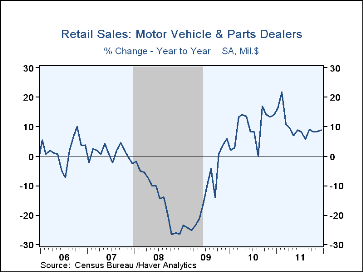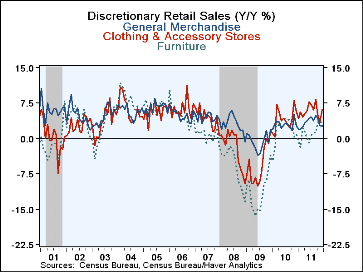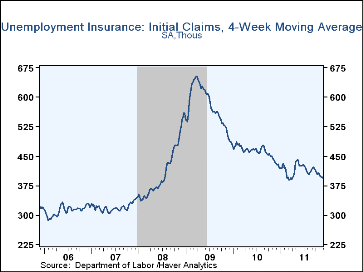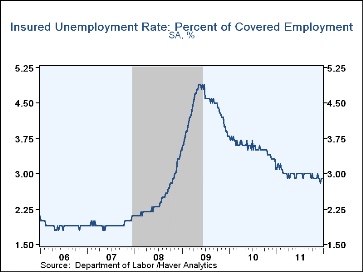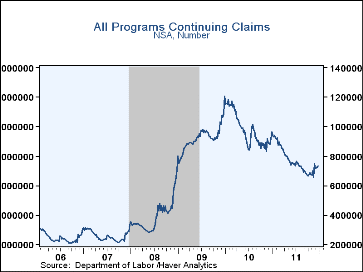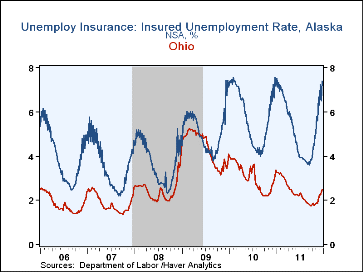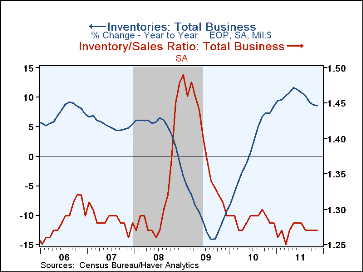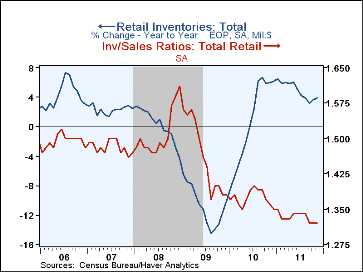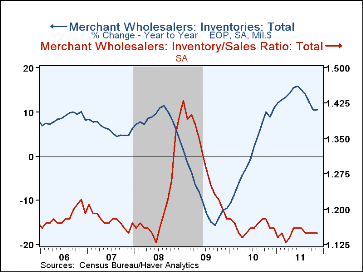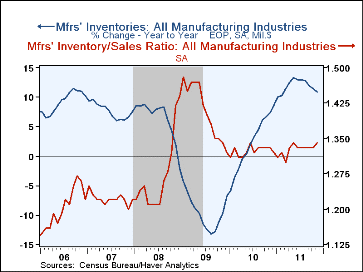 Global| Jan 12 2012
Global| Jan 12 2012U.S. Retail Sales Gain Minimally
by:Tom Moeller
|in:Economy in Brief
Summary
Consumers took a break from raising spending last month. Total retail sales ticked up 0.1% (6.5% y/y) during December following a revised 0.4% November increase, last month reported as 0.2%. Consensus expectations had been for a 0.3% [...]
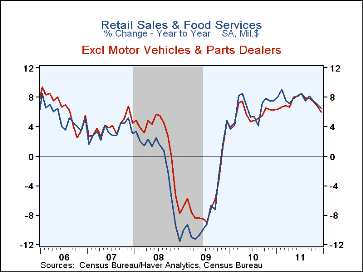 Consumers took a
break from raising spending last month. Total retail sales ticked up 0.1%
(6.5% y/y) during December following a revised 0.4% November increase, last
month reported as 0.2%. Consensus expectations had been for a 0.3% rise
according to Action Economics. The gain pulled last year's sales increase to
7.7% after the 6.4% rise during 2010. The December increase owed to a 1.5% jump
in spending on motor vehicles & parts. Less autos, retail sales fell 0.2%
(+6.0% y/y) after a revised 0.3% November gain, last month reported as 0.2%. For
the full-year nonauto sales increased 7.3%. Consensus expectations had been for
a gain of 0.3% in nonauto sales.
Consumers took a
break from raising spending last month. Total retail sales ticked up 0.1%
(6.5% y/y) during December following a revised 0.4% November increase, last
month reported as 0.2%. Consensus expectations had been for a 0.3% rise
according to Action Economics. The gain pulled last year's sales increase to
7.7% after the 6.4% rise during 2010. The December increase owed to a 1.5% jump
in spending on motor vehicles & parts. Less autos, retail sales fell 0.2%
(+6.0% y/y) after a revised 0.3% November gain, last month reported as 0.2%. For
the full-year nonauto sales increased 7.3%. Consensus expectations had been for
a gain of 0.3% in nonauto sales.
Strength in spending last month focused on motor vehicles. Auto sales gained 1.5% (8.8% y/y) compared to a 0.5% m/m slip in unit sales reported earlier this month. Sales of gasoline fell 1.6% (+8.9% y/y) despite a slight m/m gain in prices, when seasonally adjusted by Haver. Sales at food & beverage stores slipped 0.2% (+4.9% y/y) but building materials sales jumped 1.6% (5.8% y/y). Excluding both autos and gasoline, retail sales slipped 0.1% last month (+5.1% y/y) and reversed the November uptick.
Sales of other discretionary items were mixed. Sales of furniture, home furnishings & appliances fell 1.6% (+2.6% y/y) following five months of increase. General merchandise store sales fell 0.8% (+2.7% y/y), the third consecutive monthly decline. Conversely, sales at clothing & accessory stores rose 0.7% (6.0% y/y) after a 0.4% November gain. Sales by nonstore retailers fell 0.4% (+10.6% y/y). Finally, eating out was the thing to do during the holidays so restaurant sales rose 0.7% (8.4% y/y).
The retail sales figure are available in Haver's USECON database. The Action Economics figures are in the AS1REPNA database.
Why Mortgage Refinancing Is Not a Zero-Sum Game from the Federal Reserve Bank of New York is available here
U.S. Initial Claims For Jobless Insurance Are Highest Since November
by Tom Moeller January 12, 2012
Earlier workforce improvement seems to have stuttered. Initial claims for unemployment insurance increased to 399,000 last week from 375,000 the week earlier (revised from 372,000). The latest reading was the highest reading since the last week of November. Expectations had been for 375,000 claims in the Action Economics survey. The 4-week moving average ticked up to 381,750. For 2011 overall, claims fell to 409,000, the lowest level since 2007. During the last ten years there has been a 75% correlation between the level of claims and the m/m change in payroll employment.
Continuing claims for unemployment insurance notched up to 3.628M in the last week of last year while the insured unemployment rate held at 2.9%. This particular count covers only "regular" programs and does not include all extended benefit and other specialized jobless insurance programs. In the December 24th week, the latest figure available, the grand total of all benefit recipients was 7.333 mil.
By state, the insured unemployment rate varied as of December 24th with Virginia (1.5%), Texas (1.9%), Florida (2.1%), Tennessee (2.4%), Ohio (2.5%) and Indiana (2.6%) at the low end of the range. At the high end were rates in New York (3.3%), North Carolina (3.4%), California (3.6%), New Jersey (3.8%), Pennsylvania (4.1%) and Alaska (7.4%).
Data on weekly unemployment insurance programs are contained in Haver's WEEKLY database, including the seasonal factor series, and they are summarized monthly in USECON. Data for individual states, including the unemployment rates that determine individual state eligibility for the extended benefits programs and specific "tiers" of the emergency program, are in REGIONW, a database of weekly data for states and various regional divisions. Action Economics consensus estimates are in AS1REPNA.
(12/10)
U.S. Business Inventory Growth Eases
by Tom Moeller January 12, 2012
The U.S. Commerce Department reported that business inventories rose 0.3% during November following a 0.8% rise in October. Business sales also rose 0.3%. As a result, the inventory/sales ratio held at 1.27 for the fourth straight month. For November, inventories were 8.5% higher than one year earlier, and sales were up 9.6%.
In the retail sector, inventories rose 0.3% m/m after an upwardly revised 0.2% October gain. Motor vehicle & parts inventories increased a moderate 0.6% (3.3% y/y) while excluding autos inventories gained 0.2% (4.2% y/y). Inventories of building materials fell 0.4% (+1.8% y/y) and food & beverage store inventories ticked up 0.1% (5.6% y/y). Apparel inventories also rose 0.3% (10.8% y/y), furniture & equipment rose 0.2% (-2.4% y/y) and no change (3.8% y/y) at general merchandise stores. Wholesale inventories ticked up 0.1% led by a 1.5% rise (16.4% y/y) in petroleum. Less petroleum wholesale inventories also rose 0.1% (10.2% y/y). Factory inventories rose a firm 0.5% (10.9% y/y).
The manufacturing and trade data are in Haver's USECON database. Note that in a value-added feature, the database includes series calculated by Haver database managers showing sales, inventories and I/S ratios for total business less motor vehicle dealers and related wholesale operations.
Tom Moeller
AuthorMore in Author Profile »Prior to joining Haver Analytics in 2000, Mr. Moeller worked as the Economist at Chancellor Capital Management from 1985 to 1999. There, he developed comprehensive economic forecasts and interpreted economic data for equity and fixed income portfolio managers. Also at Chancellor, Mr. Moeller worked as an equity analyst and was responsible for researching and rating companies in the economically sensitive automobile and housing industries for investment in Chancellor’s equity portfolio. Prior to joining Chancellor, Mr. Moeller was an Economist at Citibank from 1979 to 1984. He also analyzed pricing behavior in the metals industry for the Council on Wage and Price Stability in Washington, D.C. In 1999, Mr. Moeller received the award for most accurate forecast from the Forecasters' Club of New York. From 1990 to 1992 he was President of the New York Association for Business Economists. Mr. Moeller earned an M.B.A. in Finance from Fordham University, where he graduated in 1987. He holds a Bachelor of Arts in Economics from George Washington University.


